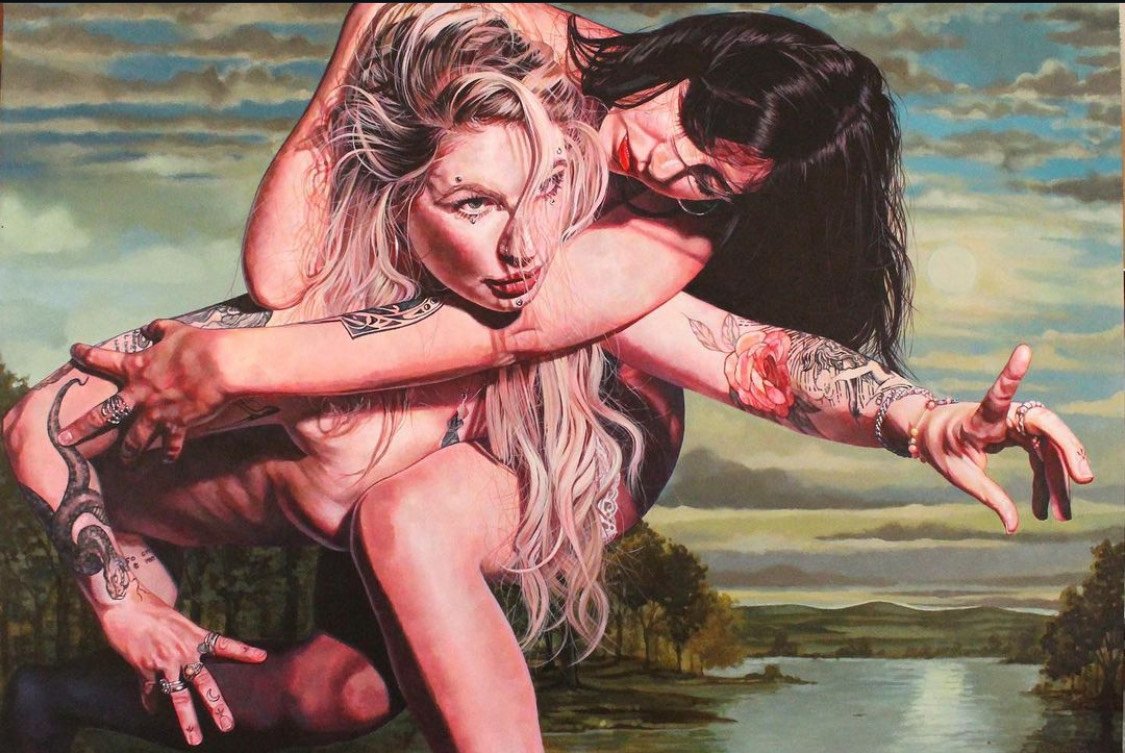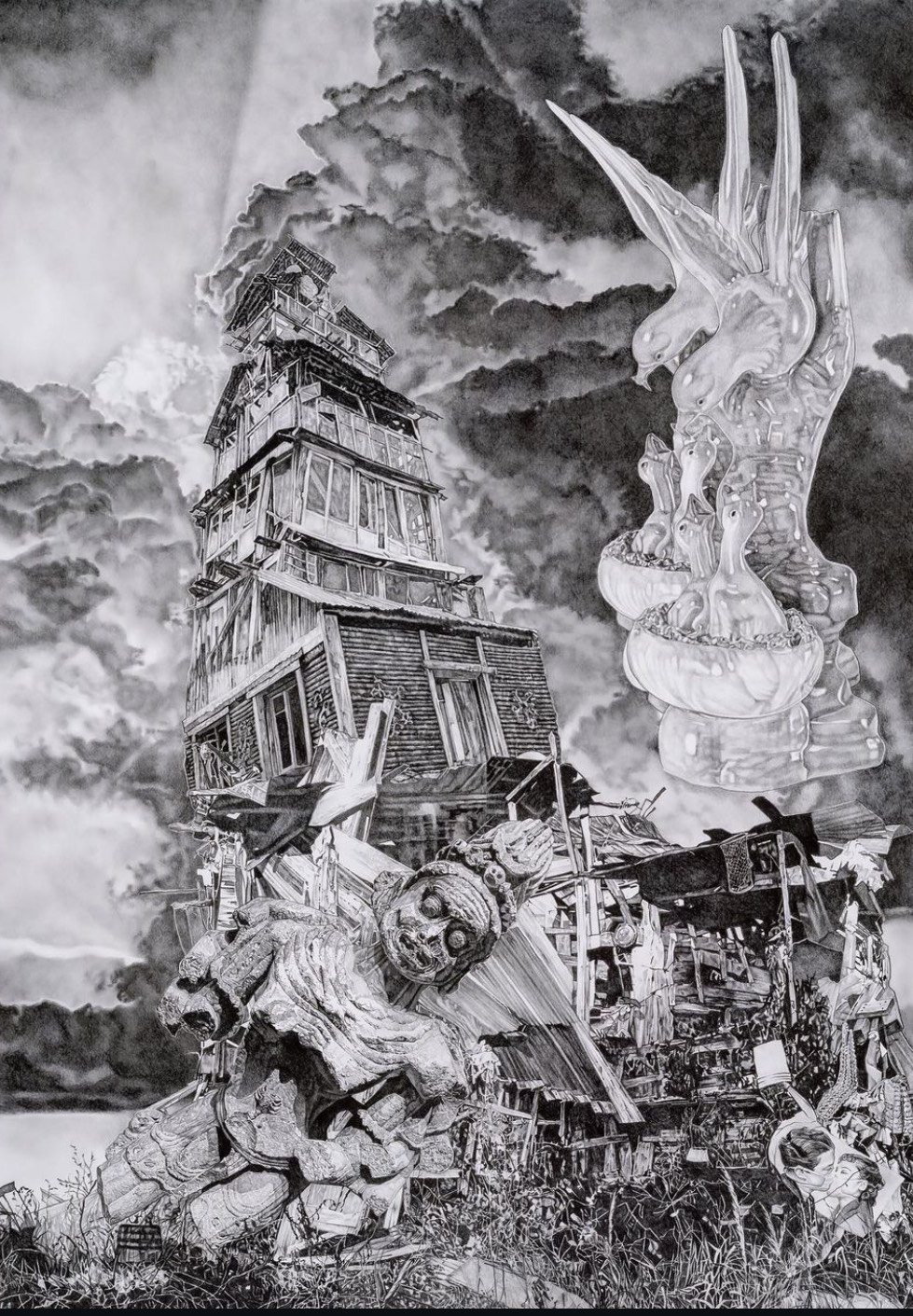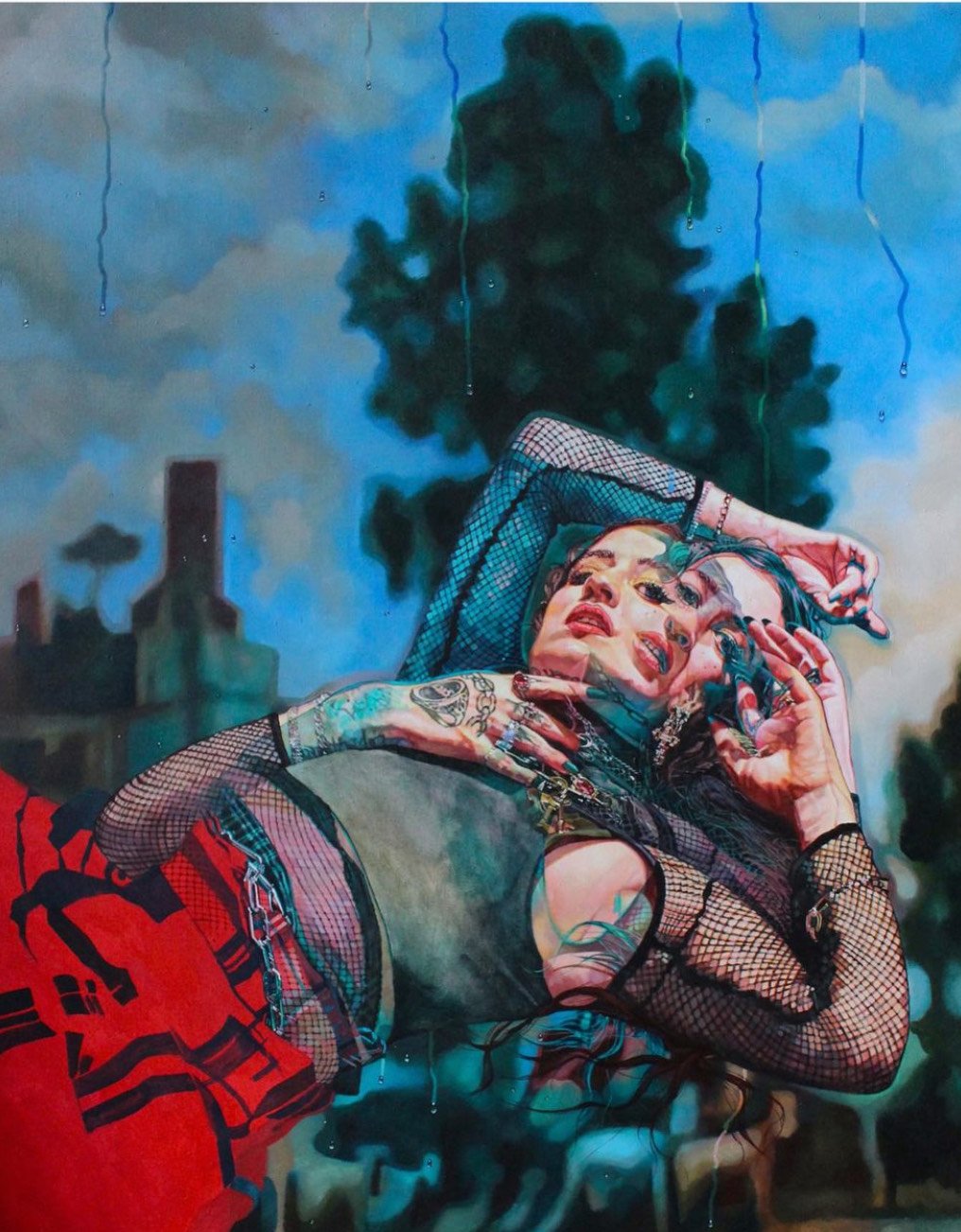XXXV: Intensities of Blood and Colour: An Interview with…Sarah Muirhead
Sarah Muirhead is a figurative artist who paints and draws objects of curiosity and bodies with an intense, voyeuristic tone. Graduating from Edinburgh College of art in 2009 she was named as one of “10 New sensations’’ by Kirsty Wark.
She has exhibited in galleries across the Uk including Lazarides and internationally in galleries such as Bernarducci Meisel in New York. Her solo show ‘Scopophilia’ was named as one of the top five exhibitions by White Chapel Gallery during Frieze week.
Muirhead’s paintings are included in private collections and public buildings such as Oxford University and Leith Theatre.
She peers at her subject through the lens of the female gaze and focuses on texture, touch, manic detail and scenes that are relatable yet unnerving.
Ornaments and objects are lovingly rendered however kitch or twisted they may be, while skin and flesh are depicted with tangible, pulsing, layered realism.
The diverse subjects in Muirhead’s paintings know they are being watched so their behaviour is altered and there is a knowing exchange between them and the viewer. The freedom of the medium and the context means that there is an academic excuse for voyeurism. There is no other context in which we are allowed to leer and scrutinise in this way - something Muirhead explores in her work. She acknowledges this exchange and creates backgrounds which are just wrong enough to allude to the artifice of the situation.
She provokes questions about control and assumption, of visual language and artistic convention. Juxtaposition is an important aspect of her compositions, using images and objects which infer something about each other and rendering them in a time consuming way that asks the viewer to take time to consider their reaction.
Muirhead's twenties were interrupted by a period of aggressive cancer treatment, survival, mortality and scarring that has shaped her work since and the lens through which she sees her subjects, and perhaps, the world around her as she attempts to describe a duality of self: a body which betrayed her very existence and a person at odds with her shell.
Join us in conversation with Sarah about the intensities of blood and colour!
Webpage: https://www.sarahmuirheadart.com/
___________________________________________
I think many would look at the title for this interview and think of, amongst others: Nitsch, Jacques Fabien, Gaultier, Bacon, Beksinski, Soutine, maybe Dunlap, de Baen, maybe Mire Lee, Culver, Alyssa Monks, Mira Schor, Bosch, Jason Edmiston, Goya, Eakins, Lossow, Bouguereau, Sickert, Gericault, Fuseli, Munch, Bourgeois, Tanning and so on. How do the visceral and the intense relate to you?
I hesitate to use words like that to describe my own work but they definitely conjure similar examples in my mind. Rather than describing my own work I'd say that both words are provocation or inspiration for me. As a figurative painter there’s an inevitable desire to insert one’s self into a canon or tradition that records and examines these aspects of human experience and to express your own version. Obviously this is profoundly shaped by our own historical and cultural context and the intensity you’re describing fluctuates as these things evolve but I do think there are eternal experiences that never loose their potency. The challenge is often how to avoid self consciousness when trying to express this and not tip into cringe.
One imagines that the meticulous and indeed surrealised realism of your work would require painstaking focus and a large apportionment of time. How does a feeling of intensity and the intensification play out over this process? Does painting exhaust or exhort it?
Missing One Who Never Was, acrylic on board.
For me, the scrutiny and hyperfocus exacerbates that sense of intensity because it is something which builds as the painting emerges. I have a layered relationship with the people and things I draw or paint. There's the initial fascination and reaction which first draws me to them. What follows is the interaction we share when researching, sketching or photographing in preparation. The most time consuming part happens in their absence and in my private space as I try to paint them and during that process they evolve into something that is just mine. The fact that this involves so much care, instinctive mark making and problem solving does mean that they twist into something that exists in its own right and with which I share a deep and slightly odd relationship. I understand that hyper-real detail can sometimes become the entire point of a painting which is something I try to avoid because it feels impersonal and dilutes things although it requires a particular skill set. Instead, I prefer to sink into the details as abstract forms and textures and when I occasionally step back to consider the overall composition I make decisions that are more about the overall noise of the image. I think the trick is being able to differentiate between attention to detail and over-working.
We spoke about the elision between ecclesiastic iconography, gore, intensity and these aspects of visual representations of heightened - ecstatic - states making an impression on us at a young age. How have such experiences influenced your aesthetic sensibility, both as a maker and consumer of art?
I’m really interested in formative memories like these! I have a lot but I specifically remember being quite young, on holiday with family and going to an exhibition of crucifixion and ascension paintings and being incredibly struck by the cartoonish anatomy, the gore and exaggeration of violence and feeling completely exhilarated and moved by it. The fingers in wounds, the rapture of the crowd who seemed kind of delirious about what they were witnessing and the gratuitous theatre of the scenes appealed to me. I also remember being struck by other peoples apparent indifference because of the ubiquitous familiarity of the image or, by contrast, their distaste for it. Some of the imagery made me immediately imagine smells and sounds, perhaps even sensation. That is a response I’ve always dreamed of eliciting in my own work. I think people experience sense memories in this way with music more than anything.
Why is the thought and praxis of sharing cares and caring about what is shared so challenging for so many in our time?
I think there’s something inherently intimate about the act of sharing something that matters to you but also an intrinsic risk of rejection, indifference or indignity. In some ways this will be outweighed at some point by urgency, investment or confidence. I think sharing cares is almost more complex now because people do it regularly on a very shallow or performative level. I’m not even criticising, a lot of this is understandably due to over-saturation, easy access to shareable media and limitation in terms of time. We are bombarded by gimmicks, causes or creations constantly and I think investing in those which are substantial and authentic takes some care and attention.
Disaster Drawing, graphite on paper.
You mentioned your reading of Byung-Chul Han recently. How has his thinking influenced yours and does any of that come up in and through your work or practice?
From an ideological standpoint, Byung-Chul Han's analysis of our current climate as being oversaturated by information and consumption, making us habitually face inwards, really struck a chord with me. The idea that we need to look beyond ourselves to find inspiration and poignancy is pretty central to my practice, even if what we look at ends up reflecting something of ourselves. He talks about the 'terror of the same' rising from our excessive need to view everything through our own experience with serious ramifications both culturally and socially. Mostly though, I found comfort in the notion that this is curable simply by re-finding our admiration, desire, attention and love for one another again. I think I have a romantic leaning and find comfort in this idea.
I'm interested in the history of tattoo guns. The language thereof and the intimated concepts intrigued me – electromagnetism, coils, repeated penetration, opening up the skin, pouring in the indelible, the permanent mark made impermanent on the cairn of a dying limb, flow, the intention, memory, mourning, power, identity, disindividuation, visibility, the hidden mark buried in its display, the skin-glove-blood-skin intimacy and magnetism, Edison's stencil pens, the copying device marking the body as a copy device of the device of copying, modification, duplication, the sign, line, pattern and pain. What is the difference and similarity between the intensities of marking the canvas versus marking the skin?
For me they are very separate practices and pursuits. Painting feels very personal and exploratory. I have no one else to worry about, it would probably be limiting if I did. I can fail or experiment as much as I wish, I can take as long as I need to and I can do things on a whim. Tattooing requires care and I feel it's in service to the person you are working on/with. It requires trust and collaboration and the experience can leave as profound a mark as the ink itself. Time is a limiting factor-perhaps a helpful one if it necessitates particular ways of making marks and developing style. Healing needs to be taken into consideration. In some ways the patterns and copies you describe are intensely ritualistic and I would only do this while painting if the ritual was the subject or point of the work. I like your thoughts on the machines we use and I think painting is similar in the sense that I have grown very particular needs in terms of pallette, set-up, prep and tools. You described the penetration and rhythm of the act of tattooing, something you learn to be sensitive to as you learn. Certain vibrations mean you are making particular marks and you feel instinctively connected to the texture of the skin you're working on and the person wearing it by extension. The process is fascinating on both ends and I think the intensity I've experienced with this work is about connection. For me painting is less explainable and is more about finding the illusive, intoxicating flow state.
Glitch, acrylic on board.
What intensities are most sublime to you, sublime in the old sense, the awe and terrifying you, but are equally undeniable to you?
I’m in danger of being nostalgic on this point because to me sublime intensity relies on universal experience and real life interaction. Narrative artwork does it for me because it usually encompasses big themes that are intrinsic to human experience and involve immersion and focus either because we are forced to confront something or because we are open enough to have the capacity to experience it. It’s difficult to achieve artificially which arguably is what artists are tasked with doing if they want to describe these feelings and achieve a physiological response. Big themes like love, injustice, loss, existentialism are hard to achieve and conversely seem to require huge subtlety and sensitivity in order to describe them without being grandiose or over dramatic but a little theatre and exaggeration is often what I find most compelling and engaging visually.
What's an intensity people ostensibly care about that you feel is grossly overrated?
I think our culture of individualism has created a strange contradiction. We obsess about the importance of our own lived experience so much that we collectively lose perspective which seems to dilute both our expression of what we are going through and our ability to truly hear the experience of others on a visceral level. I wouldn't say it's selfish as such, but certainly self-focused, sometimes it feels like there's not very much to say but an urgency to say it nonetheless. Perhaps a return to story telling from varied perspectives would balance things rather than the excessive first person narrative which increasingly seems to have a diluting effect on the audience.
Queen Velveteen, acrylic on board.
What are the most manic details of a current intensity that evokes a sense of the unheimlich for you, a pulse, a twist, attainability, maybe an appearance of voyeurism, perhaps also of mortality, control, transfiguration, relief, satisfaction, trust, dualised with despair or defeat in a medium that isn't painting? Why that thing or things and how?
I think that feeling of unheimlich is evoked, for me, in immersive situations. Performances or environments that allow for an active audience. That action may involve contact, action or just belief necessary for the work to make sense. I've always liked the acknowledgement of a viewer - the voyeuristic role that we occupy when we look at work but try not to name- we academise art appreciation rather than allowing it to be pleasurable on more instinctive levels. The intensity for me is an unspoken tension that takes place during this interaction. I've felt it in shibari performances, while looking at religious sculptures supposedly conveying an ernest connection to the divine but which allude to something much more carnal, live performance that involves true connection or even risk with an audience. There's a temptation to touch on the uncanny valley AI creations which have been on the rise for some time and a few months ago I quite enjoyed the strange, imperfect reflection of our physical reality and how eerie and grotesquely touchable it felt. I'm interested to note that the effect seems to have almost entirely worn off and I wonder whether I was just reacting to novelty because the charm has worn off and now all I see is approximation and regurgitation. It's not something I use much yet and I wonder whether in some ways it might push us further in the direction of traditional mediums at some point.
Do you think that this moment in the Anthropocene is marked, indelibly, by a paradox of the intensification of the deintensification? If so, what, culturally, in your view, are some of its most obvious symptoms?
The paradox you describe seems to be a defining characteristic of our time. I often feel like I'm hurtling through information and imagery at such an accelerated rate that I'm effectively consumed by a monstrously loud but indistinguishable white noise. There are moments when works of art, insights or tangible experiences pierce through this disorientating sameness but I'm almost always in a state of stillness and focus when I experience them. I also find viscerally intense experiences in the absurd and/or in the authentic-both things we as artists hope to be described as but which become as difficult to achieve as the notion of originality. As you rightly point out there is a simultaneous and inevitable intensification as we become swollen with input and then disengage as a survival mechanism. I find it interesting that people seem to regularly step back in order to curate what they consume and make time to take things in...or make them.





